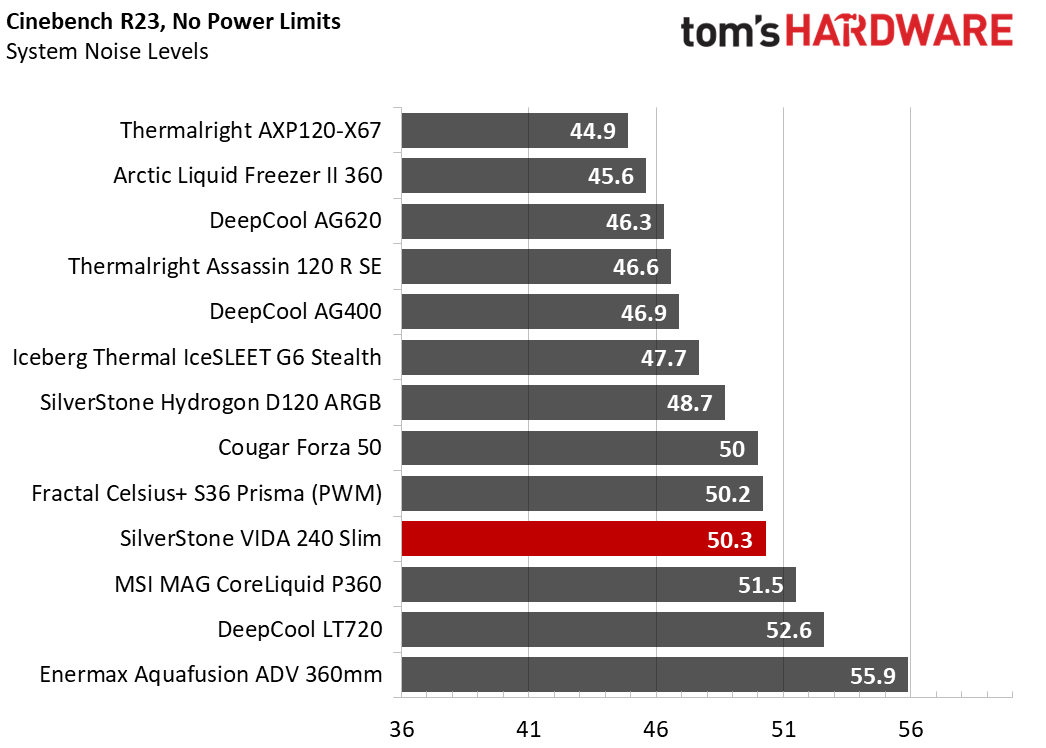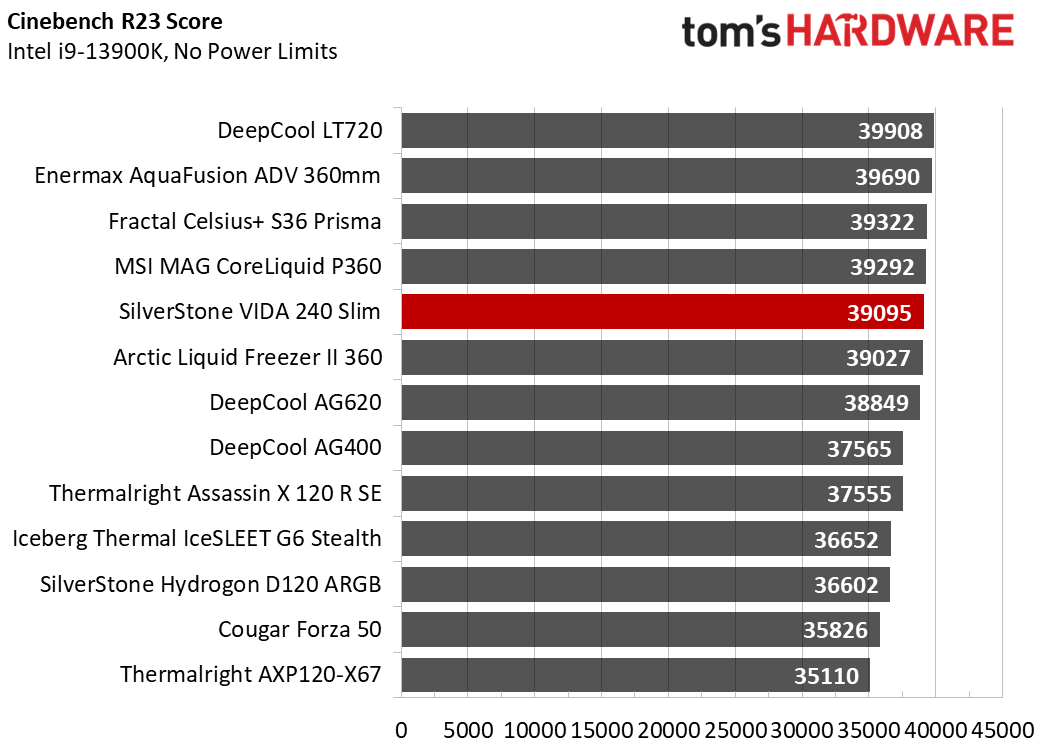Why you can trust Tom's Hardware
No Power Limits Cinebench Results
With Raptor Lake’s i9-13900K pushing speeds of 5.5Ghz+, even the strongest of coolers hit TJ max while running Cinebench R23 and other demanding scenarios. As the 13900K is designed to aim for its top safe temperature, we’ll be comparing the overall benchmark score and the CPU’s clock speeds instead.
The results below are for a 10-minute testing run. But to be sure that was sufficiently long to tax the cooler, we also retested both Thermalright’s Assassin X 120 R SE and DeepCool’s LT720 with a 30-minute Cinebench test. The results didn’t change much at all with the longer test. The average clock speeds maintained dropped by 29Mhz on DeepCool’s LT720 and 31Mhz on Thermalright’s Assassin X 120 R SE. Looking at this another way, that’s an incredibly small 0.6% difference in clock speeds maintained, a margin of error difference that tells us that the 10 minute tests are indeed long enough to properly test the coolers.
Because of the difficulty of cooling the i9-13900K in this workload, we feel the best way to compare coolers here is to record the average power consumption of the CPU. Looking at this by total watts cooled only, the VIDA 240 Slim is performing better than any air cooler tested, but a bit behind the other AIOs we’ve tested with this CPU so far.
As Cinebench R23’s multi-core benchmark will push coolers to their limits, it’s also a great test for recording the worst-case scenario of fan noise levels. Our noise charts start at 36dB, because this is the noise floor of our testing environment – we’re unable to measure noise levels below this threshold. Keep in mind that noise measurements are logarithmic, meaning the differences between the noise levels of the coolers will be bigger than these graphs would suggest.
The VIDA 240 Slim is designed for SFF cases, and it is quite impressive that a SFF AIO is handling 285W - but it achieves this at the cost of noise. While it isn’t the loudest cooler we’ve tested, it wasn’t quiet either.
Total Cinebench R23 benchmark scores show how little is lost – or gained – with different cooling solutions. Between the weakest and strongest coolers, we have a total benchmark score variance of roughly 13%. SilverStone’s VIDA 240 Slim does well here, scoring just over 39,000 points in the mult-threaded test, landing in 5th place out of the 12 coolers we’ve tested so far with Raptor Lake.
200W Cinebench Results
When restricting power consumption to a more reasonable 200W, the VIDA 240 Slim leads higher-end air coolers by 2 degrees Celsius and lower-end air coolers by more than 6 degrees C. It falls behind the S36 Prisma and LFII 360, but only by 2 degrees C.
Get Tom's Hardware's best news and in-depth reviews, straight to your inbox.
Looking at the noise levels here, the VIDA 240 does alright here. It isn’t the quietest cooler in this scenario, but it’s definitely not what I would consider “loud”.
125W Cinebench Results
The lowest power limit I test at is 125W, mainly because this is also the lowest level where I can reliably measure noise measurements. Lower power consumption causes the noise of the CPU cooler to fall below the noise created by the system fans (even while restricted to 35% speed).
When limited to 125W, the VIDA 240 Slim runs quietly and its fans are just slightly distinguishable from the rest of the system fans. In terms of tested cooling performance, it’s the 4th best result in this limited TDP scenario, beaten only by high end 360mm AIOs.
Conclusion
SilverStone’s VIDA 240 Slim impressed us. We didn’t expect an SFF AIO to have cooling capacity similar to a thicker 360mm unit, but the VIDA handled an average of 285W in our long-term testing when paired with Intel’s i9-13900K. It’s a good pairing for those wanting to use Raptor Lake in a space-constrained case. Just know that there will be some extra fan noise, which is usually a result of shrinking things down while maintaining high performance.
- MORE: How to Buy the Right CPU Cooler
- MORE: How to Overclock a CPU
- MORE: How to Check CPU Temperature
- MORE: All CPU Cooling Content

Albert Thomas is a contributor for Tom’s Hardware, primarily covering CPU cooling reviews.
-
Zescion 3% better cooling and 0.6% more performance than a DeepCool AG620 for more than double the noise and price.Reply
I don't think it's worth the hassle to go liquid with this option. -
Phaaze88 Another Pump-In-Radiator unit, but this one's got a rectangular block... Silverstone in house, or another company - that isn't Apaltek?Reply






